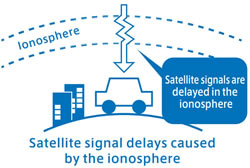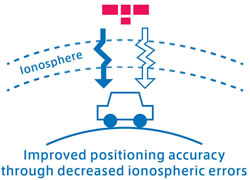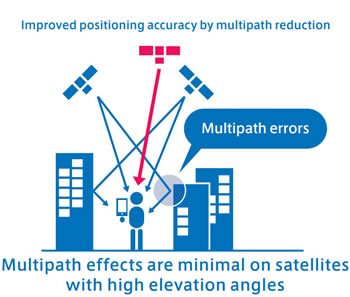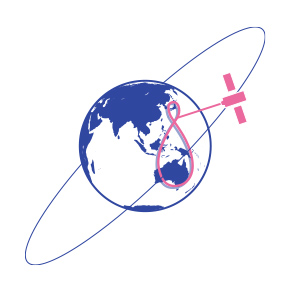Glossary
Dilution of Precision (DOP)
Also referred to as “Geometric Dilution of Precision” (GDOP). In satellite positioning, the DOP value increases when a satellite leans toward a specific direction, which leads to reduced positioning precision. Conversely, positioning accuracy is greater when satellites are dispersed evenly in the sky (when the DOP is small).
Dual-frequency positioning
This is a positioning method to use satellite signals with two different frequencies that are transmitted from a satellite. The two frequencies make it possible to analyze the effects of ionospheric delay on satellite signals, so errors can be corrected. Consequently, positioning precision is improved compared with traditional single-frequency positioning.
Elevation angle
When looking at an object in the upper air, the angle from the horizon is called the “elevation angle.” The “zenith” is 90°. The closer an angle is to the zenith, the higher its elevation angle.
Geostationary satellite
Because satellites revolve at the same cycle as the earth's rotation, from a single point they appear to be stationary. QZSS plays one part in Japan's geostationary satellites.
Global Navigation Satellite System (GLONASS)
This is the Russian satellite positioning service that is operated with original wavelengths; it is not compatible with GPS.
Global Positioning System (GPS)
This satellite positioning system is operated by the United States, and is used commonly for purposes such as the determination of location coordinates. At all times, more than 30 GPS satellites are going around to cover the whole earth.
Ionosphere / Ionospheric delay
In the upper levels of the earth's atmosphere, the layer in which electrons are separated (ionized) from atoms and molecules is the ionosphere. The speed of the satellite signals from satellites passing through this layer is slowed due to the effects of electrons in the ionosphere, so for positioning it is essential to adjust the error according to satellite signal delay.


Multipath
“Multipath” means that satellite signals do not just arrive in a straight line; they are transmitted in multiple routes while being reflected off mountains, buildings, etc. The reflected satellite signals arrive at their destination with a slight delay. The delayed time results in a more distant calculation, so this is one of the negative factors in accurate satellite positioning.

Quasi-zenith orbit (QZO)
This orbit was determined so that satellites could stand for a long period of time above Japan. On a map of the world, this orbit stretches from Japan to Oceania in the shape of an asymmetrical figure eight, with the top portion (near Japan) forming a smaller circle. This orbit—an ellipse that inclines slightly in response to the earth's rotation—actually goes around at the same cycle as the earth’s rotation.
Satellite positioning
The distance between a positioning satellite and a receiver can be calculated by measuring the time it takes for satellite signals transmitted from the satellite to reach the receiver. To calculate the precise position of receivers, satellite signals must be received simultaneously from four or more satellites of different directions.
Satellite positioning system
This is the system composed of the satellites and the ground station to manage the satellites, as well as the users' receivers. To use a satellite positioning system, users can calculate precise positions and get accurate times.




